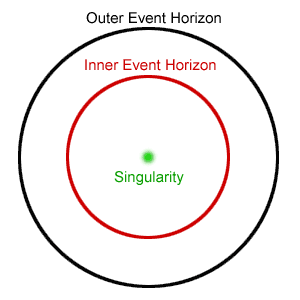




Jillian's Guide to Black Holes: Forming - Types - Outside - Inside - Finding - References - Websites
Crossection of a charged black hole

Charged black holes are rather boring without their spacetime diagrams. That's why this section seems brief. All the fun stuff happens when time-like suddenly becomes space-like and then flips back again, and I chose to lump that stuff all together in Inside section.
Photon sphere
You know, this photon sphere is pretty much like the photon sphere of a static black hole. Briefly, the photon sphere has a radius of 3/2 Rs. It is where light rays can hold unstable orbits around the black hole. It is also the last possible orbital radius, since orbiting at any smaller radius would involved going faster than light. Hypothetically speaking, if you leveled your eye there, you would see the back of your head. Ah, the photon sphere summed up in four sentences!
Event horizons
Whoa ... horizons plural?? And just how does this happen when Schwarzschild's geometry predicted only one horizon? Simple: when considering a black hole with charge, Schwarzschild's solution is no longer valid. We need something else! We need...the Reissner-Nordstrøm solution! The two scientists with that namesake solution discovered that, if a small charge is added to a black hole, the event horizon shrinks and a second, inner horizon forms just above the singularity! This inner horizon is called the Cauchy horizon. Prior to crossing this Cauchy horizon one progresses unstoppably along the time axis but with some freedom to move along the space axes. After crossing the Cauchy horizon the roles are switched: you would continued inexorably marching in space toward the singularity but you would be able to move in time. That .... that is really weird!
The more charge the black hole acquires, the smaller the outer event horizon and the larger the inner event horizon gets. If the black hole acquires a charge whose magnitude is as great as its mass (an insanely large number in the order of magnitude of 1030 coulombs), the outer and inner event horizons merge. Should the black hole acquire a charge with a magnitude greater than its own mass, both horizons vanish and leave a singularity unshielded by a horizon (a "naked" singularity). This is great. This is neat. We can get rid of both event horizons! That means we can weave and bob around the charged black hole's singularity all we please without worry about needing to go faster than the speed of light.
Practicality intrudes with a catch
There's always a catch, though (you knew this was coming). The two event horizons only disappear when the magnitude of the charge of the black hole is greater than its mass. Black holes come in 3 solar masses or more. One solar mass is roughly 1.989 x 1030 kilograms. That's huge!! You would be truly hard-pressed to amass a charge of that magnitude.
Let's just say, for hypothetical purposes, that you managed to charge up a black hole enough to disperse the two horizons. Great. Now you have to carefully monitor everything that goes into and comes out of it and must keep a great store of charge on hand. Something with that much charge would tend to rip apart the atoms around it, pulling the oppositely charged parts into itself. It's almost as if the black hole is actively trying to neutralize its charge like a person would try to warm up by drinking a cup of hot liquid (mmm, hot tea!). People give electrons personalities and desires, so I see nothing wrong with doing the same for charged black holes.
Standard singularity
The singularity of a charged black hole is the same as that of a static black hole with the exception that it is possible for the singularity to exist without any protective horizons. Physicists just don't like this, Roger Penrose included; of such events he said, "thou shalt not have naked singularities!"5 I'm inclined to agree for practical reasons regarding the charged blcak hole. The trouble just comes in when you try to describe such a place? Infinitely curved space with quantum mechanics kicking in ... messy, isn't it?
Did I say there was only one difference between the singularity of a static black hole and that of a charged one? How forgetful of me! Truly, there is one other important difference: you can avoid the singularity of a charged black hole, whereas you must eventually encounter that of a static black hole. Encountering a singularity (thus assuming that you survived the tidal forces from the trip there!) is not something you want to do, I can assume. Why is this so neat? In a static black hole, once inside the event horizon, that's it --- end of your life. However, should you survive the trip between the outer event horizon and the inner one of a charged black hole, you could in theory turn around and leave the black hole back and return to your own universe, or you could go into another universe.


